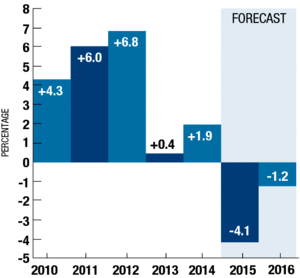
Both asphalt and concrete advocates expect increases in paving activity overall, and both note that asphalt prices haven't gone down in conjunction with oil prices as quickly as in the past. While asphalt will continue its paving prevalence, proponents of concrete contend that life-cycle costs and tight budgets may contribute to an increasing competitiveness with asphalt.
"Oil prices have been going down, and liquid-asphalt prices have finally gone downward," says Jay Hansen, executive vice president at the National Asphalt Pavement Association. "Demand for asphalt paving is expected to continue to go up 5% in 2015 on the strength of private commercial [and] residential markets, mainly, and in states that approved user-fee increases for their programs."
Ed Sullivan, chief economist for the Portland Cement Association, concurs that the effect of low oil prices is filtering into asphalt prices, but adds that it is "nowhere near the degree that people might have expected." The ratio between oil and asphalt prices is "tighter" when oil prices rise and less than when they fall, he notes.
While Sullivan expects asphalt prices will continue to ease, he says that, over the long term, "you'd expect the world economy to keep increasing its demands on oil. If there is tremendous paving activity, then asphalt prices won't decline."
But Hansen says, "When the price of oil was a $100 a barrel, we were competitive. The price of oil is now around $50, and we're going to be even more competitive, and that's the bottom line."
Hansen says the shift by many companies from recycled fuel oil to natural gas has created an energy-related cost savings per ton of asphalt paving.
Scott Sounart, technical practice leader in pavement engineering for Kleinfelder, says cash-strapped municipalities are trying to avoid large-scale reconstruction in favor of maintenance when it comes to facilities such as parking lots.
Moreover, he adds, "state transportation departments are forced to have to wait" on major reconstruction projects, also due to funding uncertainties. "The fear is that roads are being allowed to deteriorate, and that may cause problems in the years to come," he says. Down the road, higher demand for asphalt might then drive prices up.
Still, asphalt's "first cost" remains lower than concrete's, and, "for the clients we work with, it's more prevalent. I think it will stay that way, regardless of oil prices," Sounart says.
There is a recent example, however, of a state bucking the tradition. The Nevada Dept. of Transportation awarded an $83-million concrete contract last month to Fisher Sand and Gravel, although the contract was $3 million more than the low asphalt bid by Las Vegas Paving Corp. The state applied a life-cycle equivalency factor and anticipated that maintenance of asphalt paving would be three times the cost over 35 years, says Darin Tedford, NDOT assistant chief materials engineer.
For maintenance of existing roads, the traditional asphalt prevalence is a "detriment to the tax-paying public," says Leif Wathne, executive vice president of the American Concrete Pavement Association. States that have an asphalt paving monopoly pay higher prices per ton but don't leverage the competitiveness of a free-market dynamic.
The focus on so-called Band-Aid maintenance could include greater attention to concrete overlays, which have increased from nearly zero 10 years ago to about 15% for all repaving projects nationwide, Wathne adds. If DOTs encouraged healthy competition between concrete and asphalt overlays, "we could get something like 17% additional lane-miles with the same investment," he says. n






Post a comment to this article
Report Abusive Comment